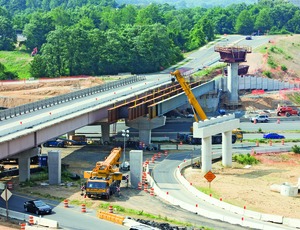
Public-private partnerships are gaining an extra boost in the United States as cash-strapped states increasingly grapple with how to address critical public-works infrastructure needs amid dwindling public funds. And the U.S. could learn a thing or two about P3 deals from its northern neighbor.
That's the consensus of construction professionals with mature experience in P3 delivery systems who gathered at a recent related conference in Washington, D.C. Canada is widely seen as a decade ahead of the U.S. in P3 delivery of major highway and public-works projects.
Canada is considered the standard for P3 contract structuring in North America, not only among partners but also in risk-sharing within teams, said Brad Watson, a KPMG partner, at the American Road and Transportation Builders Association conference on Nov. 17.
What accounts for Canada's P3 success? Solid risk-sharing models are key, as is a major commitment to them by most, if not all, of the Candian provinces, experts agreed. In addition, there are fundamental differences in the two countries' constitutions that affect the P3 approach.
"Canada has had a mix of P3 projects, both transportation and facilities," Watson said. "[That] creates deal flow and attracts competition. The U.S. has a different dynamic [and] the funding model is different." In Canada, for example, the gas tax goes to a general fund, which affects how deals are made. In the U.S., the gas tax is used to fuel a transportation trust fund that is doled out in different portions among states—and the fund's long-term reauthorization is in limbo.
Still, officials add, there are plenty of lessons that U.S. states can glean.
Joe Wingerter, who leads Kiewit Corp.'s P3 projects in the eastern U.S., noted that, in Canada, the focus is less on funding and more about risk transfer. In the U.S., P3 is seen primarily as a financing method.
Dave Jull, a senior vice president and deputy unit leader with MMM Group, a Canadian project management firm, noted another key difference in Canada, saying, "You see a consistency of documents and documentation on projects. When they're always the same, we have a shallow learning curve. The risk allocation is pretty well set. People who bid on P3s know what they'll see."
Jim Dougan, president of central and eastern Canada operations for PCL Constructors, says the provinces have embraced this delivery method for many years and set up specific agencies devoted to P3 delivery systems. "This means the process is not being reinvented over and over again," he says. "The bidding community knows the project is going ahead." Further, they know they're going to have a fair chance of winning, he adds.
Dougan says the real driver of the P3 momentum in Canada is the lending community, which drives performance guarantees. Canadian P3 participants, he notes, understand risk has to be transferred to the party that is best able to manage it. Otherwise, the rates are going to be so high that there isn't any value for the project.
Mixed U.S. Bag
The economic downturn in 2008 put a major dent in U.S. P3 efforts and almost derailed the Port of Miami Tunnel and Interstate 595 P3 project in Florida (ENR 7/19/10 p. 68). But William Reinhardt, editor of the widely read "Public Works Financing" newsletter, says he is now seeing a renewal of interest in the method.
Until now, different states have approached P3s in varying degrees. For example, California in 2009 approved its first PPP legislation with the Presidio Parkway project. But the project has become mired in legal challenges from the Professional Engineers in California Government, which has been fighting the P3 concept since it was announced last summer. Caltrans voiced its intention of awarding the contract to a consortium led by Germany's HOCHTIEF, with its subsidiary Flatiron Corp. as the contractor lead.
Notably, New York state still does not have enabling P3 legislation. However, the Port Authority of New York & New Jersey has opted for P3 delivery of the $1-billion Goethals Bridge replacement, a first for the agency.
Virginia, Texas and Florida, notes PCL's Dougan, are continuing to move forward with P3 projects. The Virgina Dept. of Transportation has long been considered a poster child for P3 efforts in the U.S. (ENR 8/21/06 p. 24) as it strives to build consistency into the process.





